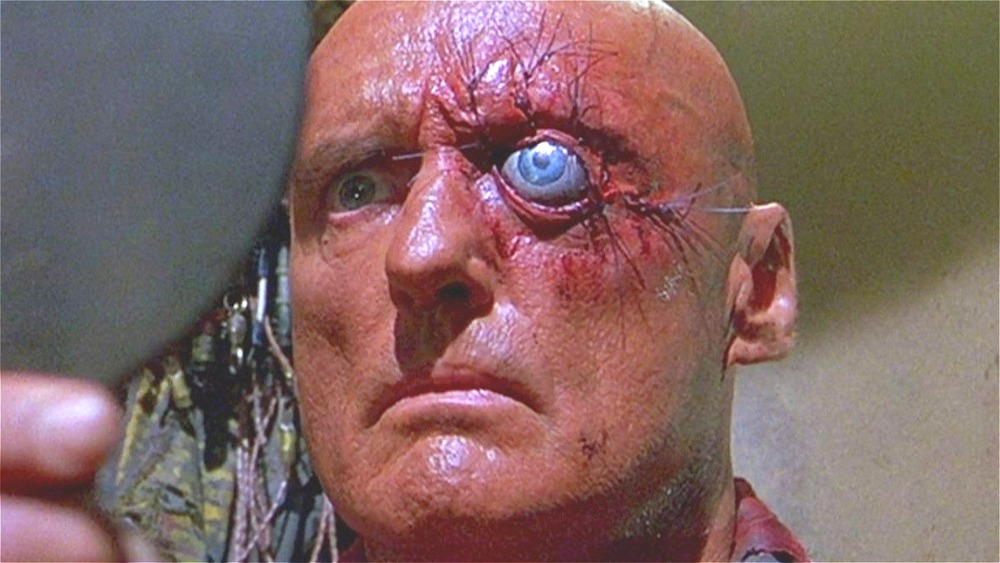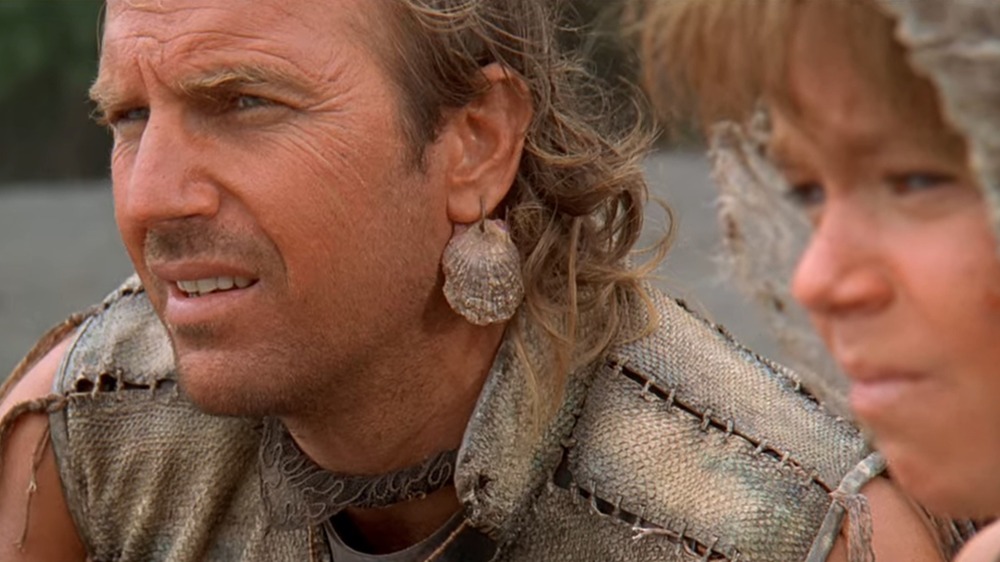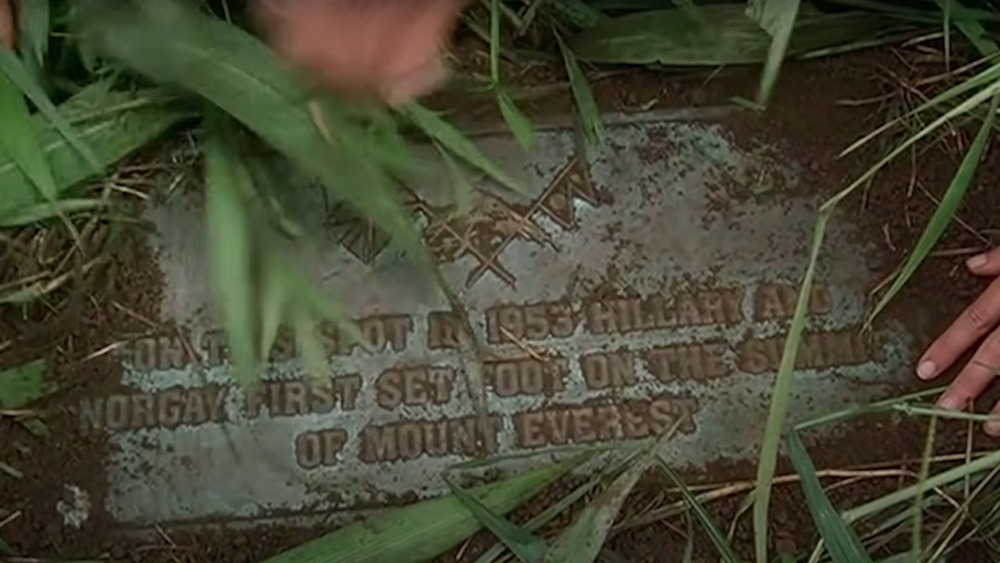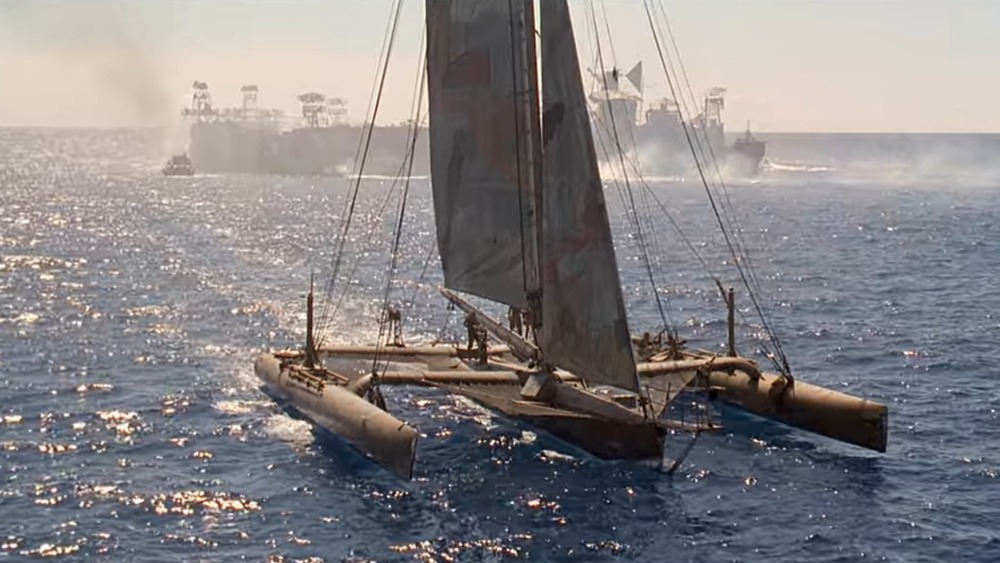The Ending Of Waterworld Explained
Waterworld's reputation was doomed before it ever hit theaters. The water-themed Mad Max 2 copycat from 1995 had a miserable production process from start to finish, which became a self-fulfilling prophecy as it dissuaded people from seeing it in theaters. Waterworld became synonymous with an enormous belly flop (perhaps unfairly), but all these years later, it's gaining new life on Netflix.
The action flick takes place many, many years in the future, after the polar ice caps have melted and turned the entire planet into a giant ocean. People live on small, man-made floating constructs, having long forgotten what life was like on land. Our rugged hero, the Mariner, played by Kevin Costner, is a mutant with gills behind his ears who spends his time sailing around, looking after only himself. That is, until he meets the young girl Enola (Tina Majorino) and her guardian Helen (Jeanne Tripplehorn), who are being pursued by a villainous pirate group called the Smokers, led by the Deacon (Dennis Hopper).
They're after Enola because she has a map to the mythical "Dry Land" tattooed on her back. After several action-packed fights between the Mariner and the Smokers, including the rescue of Enola, the movie ends with the Mariner's little group decoding the map and flying to Dry Land. There, they find a lush island with vegetation and animals.
Here's what it all means.
The Mariner heads back to sea and Enola stays on land
While the Mariner begins as a gruff, loner type, he ends as a slightly less gruff, loner type. He grew soft on Enola after risking his life and losing his boat to keep her safe. However, after delivering her and the others to the not-so-mythical Dry Land, he had a realization: He doesn't belong here. He belongs on the water. It makes sense, considering that as a mutant, he's more fit to live on the water than the other humans. So after completing his mission, he goes back to his old life.
Enola, meanwhile, is back where she was born: On Dry Land. They find the skeletons of her parents, revealing that they're the ones who tattooed her, though she barely pays them any attention and shows more interest in a cobwebbed music box. She does feel a sense of kinship to the place, however, saying, "I'm home." She doesn't want the Mariner to leave, but gives him the music box as a sign of their bond.
Waterworld ends before we can see what her life is like on land, and with no sequel on the horizon, we can only speculate. But with inexplicable horses running around the island, Enola, Helen, and the other two with them probably found plenty of resources to sustain themselves for a modest life.
The big reveal didn't make the cut
While it never made it into the theatrical cut, the last shot was supposed to have the impact of Planet of the Apes' Statue of Liberty moment. Director Kevin Reynolds told Den of Geek that the scene depicted "[Helen and Enola] standing up on this high point and they're watching [the Mariner] sail away, and the little girl stumbles upon something. They look down, clear the grass away, and find this plaque. It says: "Here, near this spot, 1953, Tenzing Norgay and Edmund Hillary first set foot on the summit of Everest."
As the highest point on the planet, it makes sense that their Dry Land haven would be Mount Everest, and the explicit connection to our world probably would have landed better. The reveal is what made Reynolds want to direct the movie in the first place, as it reminded him of Planet of the Apes. However, he left the movie near the end of post-production, so Waterworld was released in theaters without the Everest plaque. Later, it was brought back for the extended cut.
The film is even more relevant now than it was in 1995, as climate change becomes an ever-increasing threat. Truthfully, the ice caps melting would not cover that much of Mount Everest, but the film wasn't aiming for accuracy. Screenwriter Peter Rader told BBC, he wanted to make "something that heralded this urgent concern for the planet, but in the guise of a popcorn movie."
Waterworld wasn't actually a flop, but probably did little to encourage filming at sea
While Waterworld has a reputation for being a massive flop, the truth is it actually ended up turning a profit. The long, difficult production and its reputation for going so far over budget as to become the most expensive movie ever made (at the time) overshadowed what was actually put on the screen.
Ultimately, the film cost $175 million to make. It was made just before action films began to rely heavily on CGI, so most of the movie was performed with practical effects. However, with that came the constant struggle of filming on water. It proved difficult — they lost a $5 million set to a hurricane, among many other problems — and Costner and Reynolds had a series of creative differences that only increased tensions.
When it finally hit theaters, Waterworld did mediocre at the American box office, but its decent international reception and DVD sales pushed it over the edge to become a moderate success. Plus, Waterworld became a massively popular Universal Studios attraction, with a fantastic stunt show in Hollywood, Japan, and Singapore that's far outlasted the novelty of the film.
If Waterworld has any lasting impact on the film business, it's probably to deter filmmakers away from doing said practical effects while out on the water for over 100 straight days. No one wants to chase after their star actor as he's tied to a mast, floating away from safety. Waterworld is far from a perfect film, but the negative news surrounding it certainly colored people's opinions. Now, over two decades later, it's getting a second chance.



